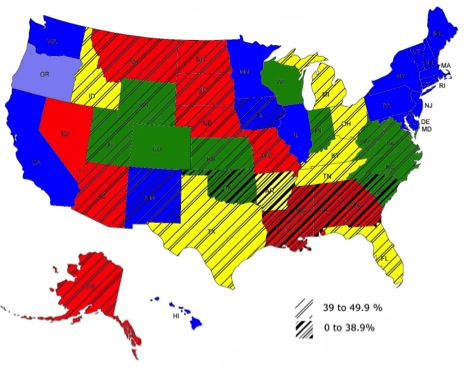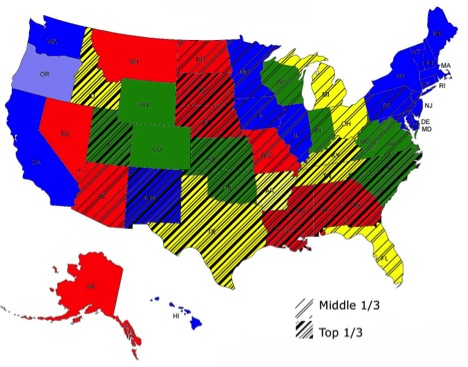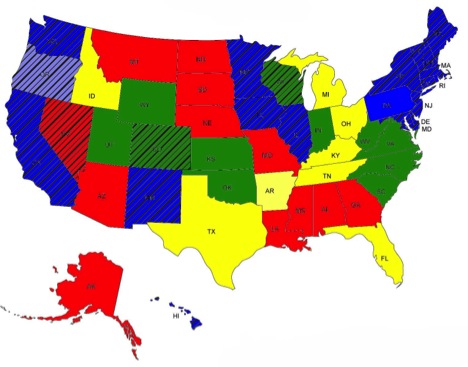Symposium: The human costs of staying out of the marriage debate
on Oct 7, 2014 at 3:56 pm
Robin Fretwell Wilson is the Roger and Stephany Joslin Professor of Law and Director of the Family Law and Policy Program, University of Illinois College of Law
Yesterday, the Supreme Court’s decision not to review any of the same-sex marriage cases it could have heard greenlighted same-sex marriage for couples in Utah, Oklahoma, Wisconsin, Indiana, and Virginia. By leaving in place the now-authoritative last words on same-sex marriage by three U.S. Courts of Appeals (the Fourth, Seventh and Tenth Circuits), couples in West Virginia, North Carolina, South Carolina, Colorado, Kansas and Wyoming may also now marry.
Figure 1. Same-Sex Marriage After the Court’s Denial of Cert.


Yesterday’s non-decision left couples in eight states exactly where they were before the Supreme Court denied cert. In Texas, Florida, Arkansas, Tennessee, Kentucky, Ohio, Michigan, and Idaho (shown in yellow in Figure 1), a lower court has struck a constitutional ban on same-sex marriage, but the right to marry has been postponed pending ultimate resolution of the case by a higher court. In these eight states, couples may not know for a year or more whether their technical right to marry will be vindicated – placing a legal cloud over their relationship. In one state, Arkansas (shown in lighter yellow), the uncertainty is especially devastating because many couples married in the brief period of time between the decision striking Arkansas’s ban and the later decision to stay the decision. Although literally married, the state is not presently recognizing those marriages – although Attorney General Holder has said the federal government will.The harms experienced by lesbian, gay, bisexual and transgender (LGBT) individuals are legion: harassment, bullying, victimization, and workplace discrimination are just some examples. Some social scientists now believe denial of civil marriage compounds the consequences of minority stress. At the University of Illinois, we are beginning work to determine whether uncertainty about one’s marriage makes matters worse.
Whatever one thinks should happen in the final analysis with same-sex marriage, there is a real human cost to the Court’s decision not to decide what should happen to marriages as well.
Even the newly authorized marriages in greenlighted states will differ in certainty from marriages in the thoroughly “blue” states shown in Figure 1. In thoroughly blue states, same-sex marriage was arrived at by state laws enacting same-sex marriage, ballot initiative, or an authoritative state court decision recognizing same-sex marriage. In all these, the right to marry will not be disturbed by the Supreme Court’s ultimate resolution of whether a federal constitutional right to same-sex marriage exists.
For many, it is inconceivable that the Court will sustain a ban on same-sex marriage when it finally acts. Some, like Meg Penrose, believe that with yesterday’s non-decision “the Court has tacitly approved same-sex marriage by allowing current Circuit court opinions to remain valid.” Others think waiting allows the Court, as Marty Lederman said, to “write against the backdrop of a nation with tens or hundreds of thousands of gay marriages, and families, and the sky not having fallen” when it finally does take a case. Bill Eskridge sees the final result as a given.
Yet an outcome favorable to same-sex marriage is not assured, even if increasingly likely. If it were assured, one would have expected the Court to have granted cert yesterday. The Court’s job is to decide cases and controversies, even those that deeply divide us.
Imagine for a moment that the Court does not ultimately find a right to same-sex marriage. What happens then to the marriages greenlighted yesterday? Presumably no decision of the Court would undo existing marriages. But the states forced today to allow same-sex couples to marry may remain deeply hostile to those marriages in a few years, even as the country tilts steadily toward same-sex marriage. Indeed, mushrooming public support for same-sex marriage has not erased pockets of deep resistance to same-sex marriage. Figure 2 shows the lowest support for same-sex marriage where the heaviest cross-hatched marks appear, based on 2012 projections by Nate Silver.
Figure 2: Public Support (and Opposition) to Same-Sex Marriage in 2012

Even if the Court waits several years, the resistance to same-sex marriage will have receded but not have gone away, as the 2016 projections in Figure 3, adapted from Nate Silver, show. By 2016, support for same-sex marriage is projected to remain below fifty percent in twenty-one states. Demographic changes likely will make acceptance even more rapid, but not so rapid that all resistance fades away.
Figure 3: Public Support (and Opposition) for Same-Sex Marriage in 2016

If the Court ultimately upholds a ban, it is not at all clear that the very electorate that erected those bans will not resurrect them as to future marriages.
Meanwhile, today’s non-decision carries a very real cost for the democratic process of voluntarily engaging same-sex marriage by legislation or at the ballot box. As Figure 4 shows, that democratic process essentially ground to a halt as soon as litigation over same-sex marriage shifted into the federal courts.
Figure 4: The Evolution of Same-Sex Marriage

After Hollingsworth and Windsor, state legislation mattered far less as everyone began waiting on an ultimate resolution by the Supreme Court. And why wouldn’t it? Legislators would not have to spend capital on something being “solved” by the federal courts. And gay rights groups very reasonably do not want to bargain in state houses for same-sex marriage with so many victories coming from the courts.
Eskridge predicts that the Supreme Court’s non-decision “will force more public deliberation about this issue all over the United States.” I wish it would. Marriage has always been the quintessential state issue, with a handful of notable exceptions, including interracial marriage.
And that democratic process yielded important gains to both sides. Voluntary recognition of same-sex marriage by the legislature gave same-sex couples the benefits of marriage today — benefits that are not under a legal cloud And same-sex marriage legislation delivered important, if modest, concessions to those who adhere to a traditional view of marriage, as Figure 5 shows. For example, religious organizations received assurances that they would not violate state anti-discrimination laws if they declined to open their space to a same-sex wedding reception. By contrast, states that recognize same-sex marriage by judicial decision give no protection to religious objectors that objectors did not already have.
Figure 5. Degrees of Religious Liberty Protections in Same-Sex Marriage States

We can imagine that many in the greenlighted states will chafe at same-sex marriage. As Figure 6 shows, five of the greenlighted states rank among the top third of the US on the index of religiosity constructed by Gallop. All but two rank among the top two-thirds. By contrast, all states that voluntarily embraced same-sex marriage through legislation or popular ballot ranked in the bottom third or hovered just above it.
Figure 6: Religiosity of Voters

Oddly, how yesterday’s non-decision will affect religious organizations is a difficult question because so many states that have not voluntarily engaged same-sex marriage also do not give sorely needed protection to LGBT individuals against discrimination based on sexual orientation. Figure 7 shows state-wide sexual orientation non-discrimination laws in cross-hatches.
Figure 7: State-Wide Sexual Orientation Non-Discrimination Laws

With so much of the country not giving basic protections to LGBT individuals against discrimination in public accommodations, employment or housing, there is a lot of work to be done, whatever happens with same-sex marriage.
As I said here in 2011, “an unintended consequence of [the Supreme Court’s earlier decisions] may be to strangle the delicate process unfolding in state legislatures across the country by changing the political calculus for granting robust accommodations.” Today, waiting on the Supreme Court may forestall the hard work of figuring out, at a divisive time, how both sides can be respectful of the other.


